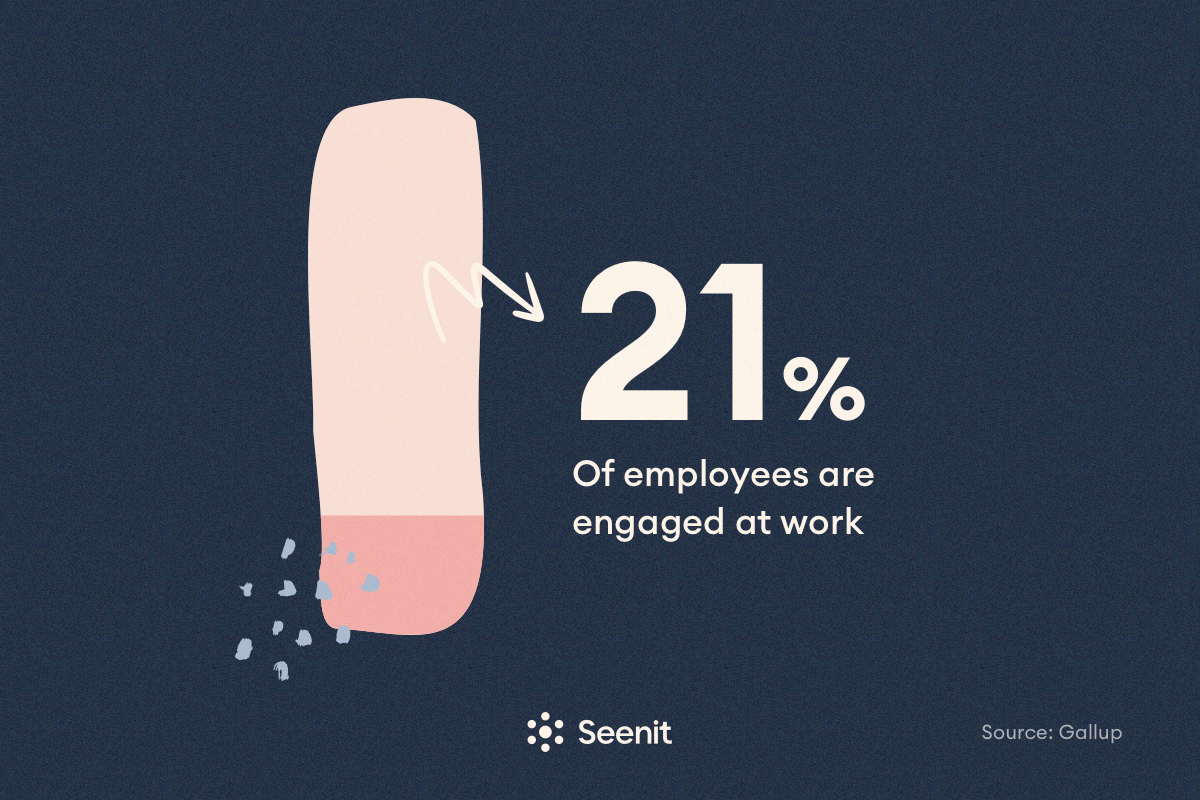In order to begin to improve employee engagement, it’s essential to understand what it is first. Employee engagement is the commitment, enthusiasm and energy employees feel about their work. Employees who are engaged in their work are more productive and less likely to leave their jobs.
Conversely, a disengaged employee can cost a business up to a fifth of their salary. This means that a worker on an average salary of £35,000 would cost a business £7,000 a year in lost productivity. Unfortunately, only 21% of employees are engaged at work. That’s why it’s so important to invest in employee engagement. In this article, we will discuss 17 proven ways to increase employee engagement. Take a queue from these actionable tips on how to increase employee engagement in your own workplace.

17 ways to improve employee engagement
If you’re ready to start improving employee engagement in your workplace, the good news is that you can do several things. Here are 17 proven ways to increase employee engagement to get you started:
1. Share Purpose & Company Mission
Employees need to know what your company stands for and its mission. If you still need to create a company mission statement, now is the time to create one. Make sure to communicate your company’s purpose to your employees regularly. This will not only help them understand the company’s goals, but it will also motivate them to work harder to achieve those goals. It can also make them feel like they’re a part of something larger than themselves, which can boost engagement.
2. Encourage autonomy
Employees should have a certain degree of autonomy in their work. This means giving them the freedom to make decisions and take actions without having to get approval from a manager every time. When employees feel like they have some control over their work, they’re more likely to feel involved and excited by it. They’ll also feel less like a number and more like a valuable team member.
3. Ensure the right tools are available
Employees can’t do their best work if they don’t have the right tools. So, you must ensure they have everything they need to do their jobs effectively. This includes things like the latest software, a comfortable workspace, and any other tools they might need — like a company car or laptop. Without the right tools, employees can quickly become frustrated and disengaged.
4. Encourage quantitative feedback
Feedback is one of the key drivers of employee engagement. It lets employees know how they’re doing and what they can improve. However, not all feedback is created equal. In order to be effective, feedback needs to be specific, objective and timely. Rather than simply telling an employee they did a good job, give them specific quantitative feedback about their work. This could be how they improved sales by X% — this will let them know exactly what they’re doing well. This is important because it allows employees to focus on their strengths and continue doing what’s working. It can also make them feel like their hard work isn’t going unnoticed. Make sure you do this regularly, for example by holding quarterly and annual reviews.
5. Encourage qualitative feedback
As well as receiving quantitative feedback, employees also need qualitative feedback. This type of feedback is more subjective, such as whether an employee is a good team player or how they handle customer complaints. You can plan one-to-one chats and team meetings to give employees this type of feedback. Just make sure it’s constructive and that you’re providing specific examples. This will help employees understand how others perceive them and it can also give them insights into areas where they might need to improve.
We’ll deliver our latest content straight to your inbox
6. Make recognition an integral part of the culture
Everyone likes to be recognised for their hard work. So, make sure you’re doing this regularly in your workplace. There are lots of different ways to do it, such as shout-outs, peer-to-peer recognition and monetary benefits. Whatever method you choose, make sure you’re doing it frequently enough that employees feel appreciated. A great way to encourage a culture of recognition is using an employee-generated video platform like Seenit which can help to make it easy and fun.
7. Review internal communication strategy
The way you communicate with your employees can have a big impact. Make sure you’re using the most effective channels for different types of messages. For example, important announcements should be made via email, while more informal updates can be shared through your instant messaging services or an intranet. You should also consider using video conferencing and webinars to keep employees engaged, especially if they’re working remotely.
8. Prioritise employee wellbeing
If employees are feeling stressed, burnt out, or sick, they will not be engaged in their work — even if they have the best intentions. You need to make sure you’re doing everything you can to support employee wellbeing. This includes providing things like flexible working, mental health support and healthy food options. It’s also important to encourage employees to take breaks, holidays and sick days when they need them.
9. Provide development opportunities & regular training
Employees want to feel like they’re constantly learning and developing. It’s important to provide them with opportunities to do this. This could include things like on-the-job training, online courses, or attending conferences and workshops. You should also consider offering employees the chance to take on new responsibilities or assignments that will help them develop new skills.
10. Give opportunities to work on passion projects
Everyone has something they’re passionate about, whether it’s a hobby or a cause they care about. From time to time, allowing employees to dedicate some of their work hours to passion projects can be a great way to engage them. This could be anything from developing a new product to organising a charity event. Not only will this make employees feel more engaged, but it could also lead to some great new ideas for your business.
11. Provide mentorship & coaching
Mentorship and coaching programs can help employees feel supported and motivated, and they can also provide development opportunities. If you don’t have the resources to run a formal program, you could consider pairing employees up as mentors and mentees. This can benefit both parties, as the mentee will get support and guidance, while the mentor will get the chance to share their knowledge and experience.
12. Train the management to foster employee engagement
Employee engagement starts at the top. If managers are not engaged, they’re not going to be able to pass this on to their teams. Make sure you’re providing training and support to help managers foster a culture of employee engagement. This could include things like coaching, workshops, or even just regular check-ins.
13. Improve onboarding process
The onboarding process is critical for employee engagement. It’s the first impression employees have of your company, so you need to make sure it’s a good one. Take the time to create a comprehensive onboarding program that covers everything from the company culture to the expectations of the role. You should also consider having a dedicated onboarding buddy for each new employee. This person can answer any questions and help the employee settle into their new role. Using a platform like Seenit to create employee-generated onboarding content can also be a great way to engage employees from the start, and make them feel like they’re part of the company from day one.
14. Show some flexibility and empathy
This is more important than ever in these uncertain times. Employees are dealing with a lot of stress and uncertainty, so understanding is important. You as an employer can help ease some of this stress by being flexible with things like working hours and locations. You should also be empathetic towards employees who are dealing with personal issues or challenges. Always make sure you lend a listening ear and offer support where you can. You can also offer additional support for those who are struggling.
15. Set up an employee resource group
Employee resource groups (ERGs) are a great way to engage employees and promote inclusion. These groups are designed to support employees with shared interests or backgrounds. They can provide a space for networking, mentorship and career development. ERGs can also help raise awareness of issues that matter to employees, and they can be a great way to foster dialogue and open communication. This is especially important in today’s climate, as many employees now work remotely and might not have the same opportunities to interact with others.
16. Organise company outings
Company outings are a great way to build morale and team spirit. They can also be a great opportunity for employees to get to know each other outside of work. If you’re planning an outing, make sure it’s something that everyone will enjoy. You could organise a group activity like bowling or laser tag, or just go for a nice meal or drinks. Whatever you choose, make sure it’s something that employees will look forward to. You could include them in the planning process to get their input and ideas.
17. Provide each team with team engagement budgets
This is a great way to empower employees and give them the freedom to come up with their own ideas to improve employee engagement. It also shows that you’re willing to invest in the team’s happiness. Each team can use their budget to organise events, outings, or anything else that they think will help improve morale and build team spirit. This is a great way to get employees involved in the engagement process and can also help promote creativity.
There are many different ways to improve employee engagement. Finding what works best for your company and your employees is important. There is no one-size-fits-all solution, so it’s important to experiment and see what works best. Keep communication open, and always be willing to listen to employee feedback. You can also measure employee engagement through surveys, focus groups, or even one-on-one conversations to assess employees’ feelings.
With a little effort, you can create a workplace that employees love and want to do their best in. Get started with Seenit, the employee generated-video platform. Get in touch today to find out more.




